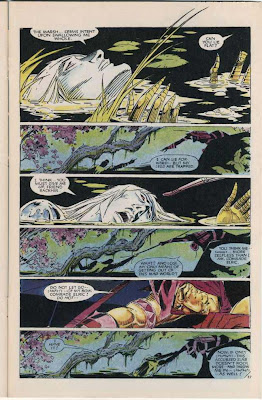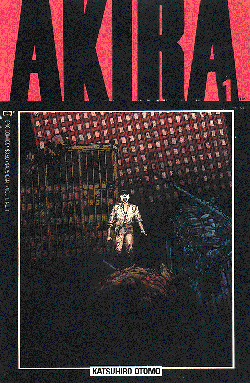 Okay, Frank Santoro here, and this one’s for all the color nerds out there. It’s just my notes, fragments of an interview with a master.
Okay, Frank Santoro here, and this one’s for all the color nerds out there. It’s just my notes, fragments of an interview with a master.
Steve Oliff may be one of the best color artists in comics history. I tracked down the 30-year veteran of comics and asked him a few questions about some old color processes used in the late ’70s and early ’80s. He was kind. And patient. But please know that these notes, this “interview,” is really just to satisfy me and to add fuel to the fire of my own obsessions—so forgive me if this isn’t a super well rounded portrait of an artist. (And thanks to Steve.)
I was just reading, looking at everything Oliff had worked on, collecting the coolest and weirdest crap comics just cuz he’d colored them, and trying to make sense of how the processes changed over the years. He ushered in the computer era when he found a way to color Akira by the most insane process in 1988. And before that he worked on Marvel’s first full color comic magazine in the ’70s, The Hulk!, the first book there to use the “blue-line” process.
Blue-line. Blue-line color process. What is it? From what I understand, generally, it’s when the “black line” (the inked, finished art) is printed on an acetate sheet and then is also printed in non-photo blue on Bristol board at the same size. The acetate is usually hinged at the top of the board and brought down for reference. Anyways, the board gets the full color treatment, watercolor, acrylics, dyes, anything that’ll stick to the board. The colored page and the black-line page are shot by the camera separately. The idea is that the blacks stay black and the color stays balanced. You can paint the fuck out of it and still have these crisp containment black lines that’ll shape it all up.
An example of this process is found here. Read the intro paragraph about original blue-line comic art.

I got really into reading Howard Chaykin‘s Time2 and really into trying to understand how Steve Oliff went about coloring it. Time2 has a fresh, light palette that adjusts to the mood of the story ?very nicely. The light “pastel” palette was so different from the ?traditional four-color books on newsprint and the garish Baxter paper ?books of ’84-’86. ??”Flat” colors for the most part with slight airbrushed gradients that? presages computer color’s ubiquitous “modeled” color of today—a look that ?Oliff was instrumental in creating.
Yet, the effects achieved in? Time2 are remarkable because they do not rely heavily on “modeling” ?and gradients; the colors are restrained and generally “flat.” Oliff ?arranged the mottled, impressionistic flat areas of color to create ?tension and mood and it worked beautifully. White Conté crayon ?highlights and watercolor paper-like textures reveal a hand? with a liveliness rarely seen in color comics. This approach ?pairs very well with Chaykin’s style, which is important to note.? Subtleties of color,? highlights, and patterning that mirror Chaykin’s style unify the color and line ?art, like a second voice providing a stellar harmony.
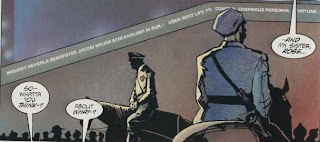
Note the blue flourish on the back of the policeman to the right. And how it rhymes with the sky on the adjacent page.

These flourishes and the simple painted sky background were? not possible with the four-color process. All “art” was made on the ?black line with the four-color process. A colorist may have implied a? stormy sky in his color guides, but it would be left to an unknown? “separator” to create the sky—a chance that most artists and? colorists were not, generally, prepared to make. It was very uncommon ?to see elements created by the artist printed on any of the color ?plates. For the most ?part the artist was limited to the black line, and the colorist to flat? color, screens and mechanical gradients notwithstanding.
Santoro: Was this (Time2) your first experience with the blue-line process?
OLIFF: Yes, this was the first time I’d tried the blue-line process. It was the second time I’d worked with Howard Chaykin, though. The first time was in 1978 on The Stars My Destination. On that project we just did full-color art. I was laying in the basics and Howard did the finishes.
On Time2, Howard and I worked very closely. He sent me a pile of color references, from painted TV Guide covers to fashion photos. He had a late-forties to early sixties flavor to all of it. He does extensive reference research for his projects. That naturally carried over to the coloring.
Time2 had a couple of things different about it. First, many of the pages were designed as double-page spreads, and could be linked thematically. I knew there weren’t going to be any annoying ads that could pop up randomly with God only knows what kind of a color scheme to compete with my work.
Then you have the real advantage of blue lines: You can use any paint, pencil, etc., that you want. I could use gouache (opaque watercolor). And in reproduction, that word “opaque” is crucial.
I’m going to digress a bit, but this is important.
Comics had traditionally been colored on the guides using Dr. Martin’s Radiant Transparent Watercolors. These guides were not used for reproduction, just as an indicator for the engravers and separators.
When people started doing full-color, they were looking for bright, saturated colors, which Dr. Martin’s gives on the original color art. However, when you try to reproduce the transparent colors, because of the crystalline structure of the pigment, and the bouncing of the light between the white paper and the pigment, the colors will over-saturate, and react weirdly.
With opaque colors, the light hits the paint and is directly reflected back to the camera or scanner without the trip under the transparent colors. This gives a much more controllable color that can be accurately reproduced.
Up to that point in my career, I had been using transparent dyes, felt pens, and only a very little opaque Cel-Vinyl animation paint. Gouache changed my whole approach to color. And best of all, I could mix the gouache thin enough that I could airbrush with it. (And there is a lot more airbrush work on Time2 than at first meets the eye.)

One of the main things that separates Time2 from my earlier coloring jobs was that I mixed up my own special palettes of colors to airbrush, and then I used some of those same colors to paint with. Then on top of that, I was using some of the leftover frisket (a masking film) to create patterns of color. For instance there is a big shot of a girl sitting on a couch. The pattern on the fabric is mostly used frisket pieces. We used spatter and colored pencil extensively to give texture.
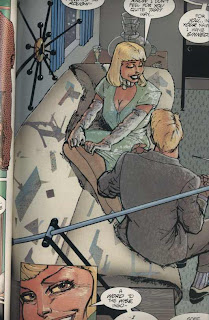
I also used Pantone films to cast shadows over the colors once they were rendered.
And finally, Howard came back in and gave a lot of the faces hard edged color. He felt some of my color edging was too soft, so he cut in some highlights.
I was out of the loop on the proofs, so I don’t know what was going on in that department. Howard and the editors were more on top of that. Time2 has been one of the most popular works of mine among colorists. I can remember Brian Haberlin mentioning it as one of his favorite color jobs before he became a pro. I think it still holds up. I’m proud of it.
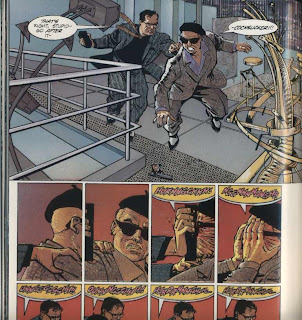
The blue-line process changed the way colorists essentially ?”created” color. To get an insight on how different the process was, ?I asked Steve to compare Time2 to another book he worked on only the ?year before: Mike Kaluta‘s Starstruck series.

When I worked on the Epic titles: Timespirits, Coyote, The Bozz Chronicles, and Starstruck, they were all flat color books. (Timespirits eventually switched to full-color stats for the last few issues.) It was an adjustment for me. It was like working on Captain Victory and Starslayer for Pacific, which I’d done in the early ’80s.
How were your guides interpreted for Starstruck?
I’m guessing ?paper seps that were then shot with screens to get percentages. This is more or less the same process that had been in place for fifty years ?in comic books.
Starstruck was separated by one of the old hand separation companies, probably Chemical Color up in Connecticut. They did a decent job considering I hate to write numbers all over my guides, so they were left to guess a lot about exactly which colors I wanted.

Your arrangement of bright flat colors in Starstruck, to me, really? suits Kaluta’s work. It feels like you really looked at his own color? work and really attempted to dovetail nicely with his line work. I? don’t get that feeling with Elaine Lee‘s colors on the first two ?issues. I also think it’s a very modern palette that holds up over ?time. Very fresh.
Starstruck had great art, and I was forced to think things through in a flatter way. However, I’ve never approached any project without trying my best to figure out which color approach best suits the story and the artist. Also, whenever possible I talked to the artists about what they were looking for in the color. My goal has always been to be a real collaborator on the art, and do everything in my power to bring out the best in it. That’s not always possible, but I tried whenever I could. I didn’t have much contact with Mike on that book, though. I was called in because the editor (Archie Goodwin) either wasn’t totally happy with Elaine’s work, or she was behind on deadlines.

Please elaborate on the mid-’80s and the choices offered: four-?color, blue-line, Photostats, grey-line. Did you feel that one process was superior or did you have? a preference? They are understandably different processes with their? own quirks. Did turning over your guides to a separation house and? getting back lazy seps fuel your interest in blue-line? Obviously with Akira that was an issue (I read your essay on Akira color), but before you really even thought about computer color, lets ?say in ’85, ’86, which process did you feel best represented what you ?were trying to do? Because from what I can tell you were doing? grey-line, blue-line, and four-color in 1986.
I was doing all different color styles around then, true, but I’d been thinking about coloring using computers as early as ’82-’83.
For me blue lines were a step sideways in my color evolution. I’d been doing full-color work since right after I worked for Howard in ’78. I was one of the first colorists to use the Marvel double-print black system that Rick Marshall put together for The Hulk! magazine. They called it SUPERCOLOR, I think. It was an attempt to find a blue-line substitute.

The idea of their system was similar to blue-lines, except that they printed two copies of the line art onto a type of Photostat that supposedly wouldn’t shrink (therefore preserving registration). I did full color on one, and the other was used for the line art. Between the two of them I could get a variety of effects. I could knock out the line art to get glass FX, and I could also add Zip-A-Tone to the black to get darker tones and set moods.
This system worked fairly well, but the problem for most colorists was that you had to work on a very slick surface that only took certain color mediums. I developed a system for coloring on them that worked well, but it wasn’t like working in paint and colored pencil, etc. I could use airbrush, however.

The problem at the time was that editors were looking for ways to economically get better color, but there weren’t many books to try things on. After the Hulk series got canceled, there wasn’t any work for a full-colorist.
That was a rough spell for me, but I got little jobs here and there until Pacific Comics began. They did flat color on newsprint until Bruce Jones’s Alien Worlds and Twisted Tales came out. On those they did the jump to Baxter paper, but the first issue of Twisted Tales was hand-separated. I did most of the guides for that issue. By this time I was coloring my guides on photostats, so I just did them like I was doing full-color even if I knew it was going to be flat separations. I put an acetate overlay on them, which was where I wrote in the color codes. (I REALLY hated putting those numbers in.)
That all changed on one Al Williamson story for Alien Worlds. They saw how nice the guides looked and decided to try to get a clean full-color shot, which they did, so they switched then and there to full-color. I still have a daily strip that Al sent me in appreciation for that job.
But the age-old problem of shooting full-color art was still there, so someone came up with the grey-line system, which was a watered-down blue-line approach. It worked up until the end of the Eclipse line of comics.
When Time2 came out, and so did The Dark Knight, the blue-line was the hot way to get full color.
(Oliff would continue using the blue-line technique and his ?collaboration with Chaykin through 1988 with Blackhawk, from DC ?comics.)
Would you comment on this series briefly? I feel like you grew more? comfortable with the blue-line process here and created a palette and? look that was very suitable to the 1940s setting. Its a bit less? frenetic than Time2, but still very “lively.” There are also more ?instances where you are painting in backgrounds that Chaykin is not delineating on the black line.

After Time2, when Howard landed the Blackhawk series for DC, he got me signed on as colorist. All the stuff I learned on Time2, I was then able to use on Blackhawk. My painting ability got stronger and cleaner, and Howard felt confident to let me add background and design elements. I still have many of those pages, and I’m amazed at how much work I put into them.
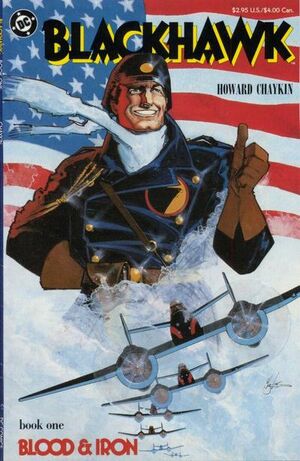
Would you elaborate on the grey-line process used ?at Eclipse? Was this the same process that Marshall Rogers used for? his Scorpio Rose comics? Did processes change at Eclipse and Pacific ?over the years? I’ve heard that Marshall was very involved in?developing Eclipse’s color process in the early ’80s.
I don’t know if Marshall had anything to do with the development of the grey-line system or not. The grey-line process was a hybrid of the blue-line designed for drum scanning. Blue-line traditionally had the blue line printed on heavy illustration board. That meant they had to be shot photographically. The grey lines were 10% line art printed on a flexible Photostat. That was what we colored. The black line art overlay was also flexible. The pages were done at printing size, and ganged up to scan a bunch of pages at a time on a drum scanner. I don’t know whether it was four or eight pages at a time, or what. This made the separations inexpensive, which allowed them to do full color at not too much more cost than flat color.
How did you feel about the Baxter paper books ?that came out in ’84? Camelot 3000 and the New Teen Titans. I’m not? aware of any “Baxter” books that you may have worked on.
I always thought that the Epic books I colored were Baxter books. But in general the first Baxter books were a bit much. The Baxter books did allow a wider range of colors, though. It was just that no one was quite prepared for it at first.

Moebius‘s Epic graphic novels. Were they? blue-line? Were all the Marvel graphic novels blue-line? Is the? Starstruck graphic novel from ’84 a blue-line process? Do you remember? what the first blue-line process book you saw was? I mean one that you ?saw in a production office or somewhere, not the final printed book ?but the board itself with the overlay.
Moebius was definitely blue-line. I don’t know about the Starstruck graphic novel. The Marvel graphic novels I colored were the double-print black system. (I’m not sure what the official name was for that system. I’ve just always called it that.) The Death of Captain Marvel, God Loves, Man Kills, Super Boxers, Revenge of the Living Monolith were all that system.
The only one that was totally different for me was the Alien Legion graphic novel. On that one I colored directly on Frank Cirocco’s art. I’m not sure what the rest of them were.
I don ‘t remember seeing any blue-line jobs in the office until after I had done a few myself. In addition to Time2, I colored about three Classics Illustrated graphic novels for First Comics.
I asked a fairly reliable source about who ?actually interpreted the guides for the separation houses in the ’60s ?and ’70s and was told that Marvel and DC had the same separation house.? “It was little old ladies in Connecticut who made the separations.”? Have you ever heard anything like that?
Oh, yeah. That was it. Chemical Color. It was a standard line about the state of comic coloring. When it sucked, you could blame it on the “little old ladies in Connecticut.”
postscript: anyone with info on the “greyline” process, please email me. capneasyATgmailDOTcom






 Odilon Redon
Odilon Redon











